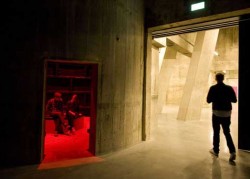It is a very exciting journey to enter Tate Modern’s new exhibition space in what used to be underground oil tanks at the former power station turned into art museum. Rehabilitated by architects Herzog & de Meuron, responsible for the original refurbishing of the place, the spaces kept their raw aspects and darkness as its main ingredients to suit the programme of videos and performances. The ambient is cavernous and you can still smell the oil that used to be stored there not so long ago.
In the brand new Tate Tanks, opened for London’s Olympic moment, the public is vital in its participation as an audience. It is an answer for the constant demand of engagement of today’s art viewers. The change from being spectators to being part of the work has been going on for a long time, at least since the 1950’s with performance art, to give an example that is part of the programme.
It is a lively experience, where you can see the artwork present itself, never in the same way, and then vanish. Not like the paintings and sculptures that occupy the collection galleries. Some of most important acquisitions for the Tanks programme up to now are Suzanne Lacy’s The Crystal Quilt, a performance of social engagement and political content, and Lis Rhode’s Light Music, a video installation from 1975.
For 2012 the Tate Tanks will be presenting a 3-month (16 July – 28 October) programme of relational art, from video to performance, going through social activism to dance. There were large cues for the first presentations. People seemed happy and lucky to be in this position. I was able to attend the first live acts at the south tank, Anne Teresa De Keersmaeker in a reworking of Fase, Four Movements to the Music of Steve Reich, performed by De Keersmaeker herself and another female dancer.
They seemed like live sculptures, all personal intimacy gone, while repetitive, almost mechanical movements were executed. Along with the hypnotic music, the piece involved the audience for more that 20 minutes. All that were present, people from different ages and cultures and even children, where caught in this timeless web that seemed to have stopped time in an timeless realm.
New sensations and emotions that are still being born and digested by the audience. A force that comes from the meeting of the public with the artworks. From a generator of electrical energy to a generator of experiences and ideas, the Tanks are surely a ride that I will like to go again many times.



